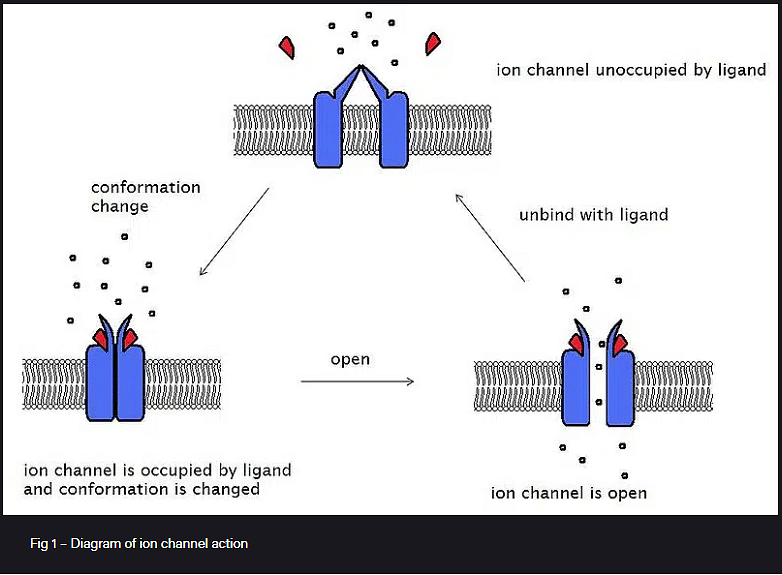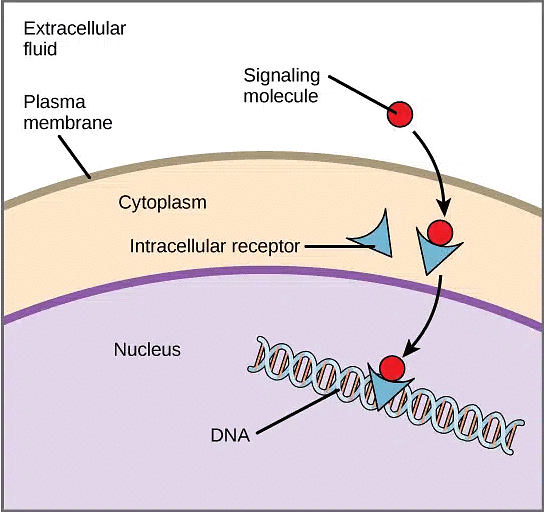Cell Signalling and Cell Receptors | Botany Optional for UPSC PDF Download
| Table of contents |

|
| Introduction |

|
| What is Cell Signalling? |

|
| Cellular Receptors |

|
| Cell Surface Receptors |

|
| Intracellular Receptors |

|
Introduction
Cell communication, a fundamental process in biology, encompasses a series of intricate mechanisms by which cells detect and respond to signals originating from either their immediate surroundings or within their own structure. This article delves into the realm of cell communication, shedding light on its various facets, including types, stages, and functions. To better understand this intricate process, readers will find detailed information in the sections below.
What is Cell Signalling?
Cell signalling refers to the elaborate process through which cells communicate with each other within their organism or with the external environment. This phenomenon occurs through several distinct pathways, playing a crucial role in regulating various functions within multicellular organisms. For instance, nerve cells collaborate with muscle cells to facilitate bodily movements. Cell signalling can be broadly categorized into intercellular and intracellular signalling. Intracellular signals originate from and act upon the same cells, whereas intercellular signals travel throughout the organism, allowing specific glands to produce signals that impact different tissues.
Types of Cell Signalling
Cell signalling molecules can be classified into several types based on their mode of action:
- Intracrine ligands: These are produced by the target cell and bind to the receptor within the cell.
- Autocrine ligands: They function internally and on other target cells. For eg., immune cells.
- Juxtacrine ligand: These target the adjacent cells.
- Paracrine ligands: These target the cells in the vicinity of the original cells. For eg., neurotransmitters
- Endocrine ligands: These produce hormones.
Stages of Cell Signalling
Cell signalling unfolds in three distinct stages:
- Binding of the Signal Molecule to the Receptor: This initial stage involves the binding of a signal molecule to its corresponding receptor on the cell's surface.
- Signal Transduction: During this phase, chemical signals activate enzymes, triggering a cascade of intracellular events.
- Response: The final stage culminates in a cellular response to the received signal, resulting in various changes within the cell.
Cell Signalling Pathways
Cell signalling pathways can be categorized into mechanical or biochemical pathways based on the distance signals must travel. Hydrophobic ligands, including steroids and vitamin D3, can diffuse across the plasma membrane of target cells and bind to intracellular receptors. In contrast, hydrophilic ligands bind to receptors on the cell's surface, allowing signals to traverse the aqueous environment without assistance.
Cell Signalling Functions
Cell signalling encompasses several receptor types, each serving specific functions:
- Intracellular Receptors: These receptors are located within the cell's cytoplasm and include two main types: nuclear receptors and cytoplasmic receptors. Nuclear receptors, characterized by diverse DNA binding domains, form complexes with thyroid hormones and regulate gene transcription.
- Ligand-Gated Ion Channels: These channels permit the passage of hydrophilic ions across the plasma membrane, facilitating neural firing when neurotransmitters, like acetylcholine, bind to them.
- G-Protein Coupled Receptors: These receptors receive a multitude of signals and trigger a cascade of enzymatic reactions upon ligand binding, playing critical roles in processes such as sight, inflammation, growth, and sensation.
- Tyrosine Kinase Receptors: Ligand binding to these receptors leads to kinase domain dimerization and subsequent phosphorylation, activating intracellular proteins.
Conclusion
Cell signalling is a remarkable process through which cells convey vital information, enabling them to respond to their extracellular environment effectively. This intricate communication involves the transmission of messages via a chain of chemical messengers within cells, ultimately leading to various cellular changes and responses. Understanding the nuances of cell signalling is essential in comprehending the intricate biology of multicellular organisms.
Cellular Receptors
Cellular receptors play a pivotal role in cell signaling, acting as essential components that facilitate communication within the intricate landscape of the human body. These specialized proteins serve as the molecular gatekeepers that orchestrate a myriad of biological responses when they interact with specific signaling molecules, known as ligands. This interaction is akin to a key unlocking a door, setting off a cascade of events within the cell.
In this we delve into the intriguing world of cellular receptors, with a particular focus on their two primary categories: cell surface receptors and intracellular receptors. We will explore their structures, functions, and clinical significance, highlighting key examples to illustrate their crucial roles in various physiological processes.
Cell Surface Receptors
Cell surface receptors, also known as transmembrane receptors, are strategically embedded within the cell membrane. They play a pivotal role in mediating cellular responses to signaling molecules that cannot easily traverse the hydrophobic plasma membrane due to their hydrophilic nature or large size. There are three main types of cell surface receptors: ion channel receptors, G-protein coupled receptors (GPCRs), and enzyme-linked receptors.
Ion Channel Receptors
Ion channel receptors act as gatekeepers, regulating the flow of ions into and out of cells. They come in various subtypes, including voltage-gated ion channels, which respond to changes in membrane potential, and ligand-gated ion channels, which open or close in response to specific ligand binding.
For example, voltage-gated ion channels play a pivotal role in the nervous system, facilitating the transmission of action potentials between neurons by allowing the flow of sodium and potassium ions.

G-protein Coupled Receptors (GPCRs)
G-protein coupled receptors (GPCRs) form a diverse group of cell surface receptors that utilize specialized proteins called G proteins to mediate cell signaling. Their structures and functions are explored in more detail in dedicated articles.
Enzyme-linked Receptors
- Enzyme-linked receptors are characterized by their catalytic sites on the intracellular domain. Upon ligand binding to the extracellular domain, these receptors activate enzymes, triggering specific cellular responses. An important subtype is the tyrosine kinase receptor, which plays a crucial role in processes like cell division and wound healing.
- When a ligand binds to a tyrosine kinase receptor's extracellular domain, receptor dimerization occurs, leading to the phosphorylation of tyrosine molecules in the intracellular domain. These phosphorylated tyrosine molecules initiate diverse signaling cascades vital for various cellular processes.
Intracellular Receptors
- Intracellular receptors are found within the cell, typically in the cytoplasm or nucleus. They are designed to interact with small, hydrophobic (lipid-soluble) ligands that can easily traverse the plasma membrane independently. Once inside the cell, these ligands bind to their respective intracellular receptors, forming ligand-receptor complexes that directly affect gene transcription and protein synthesis.
- Like their cell surface counterparts, intracellular receptors possess three fundamental domains: a ligand-binding domain, a DNA binding domain, and an amino terminus that interacts with the gene transcription machinery.
- Examples of ligands that bind to intracellular receptors include sex hormones, thyroid hormones, and fat-soluble vitamins (A, D, E, and K).
 Action of intracellular receptors
Action of intracellular receptors
|
179 videos|143 docs
|















